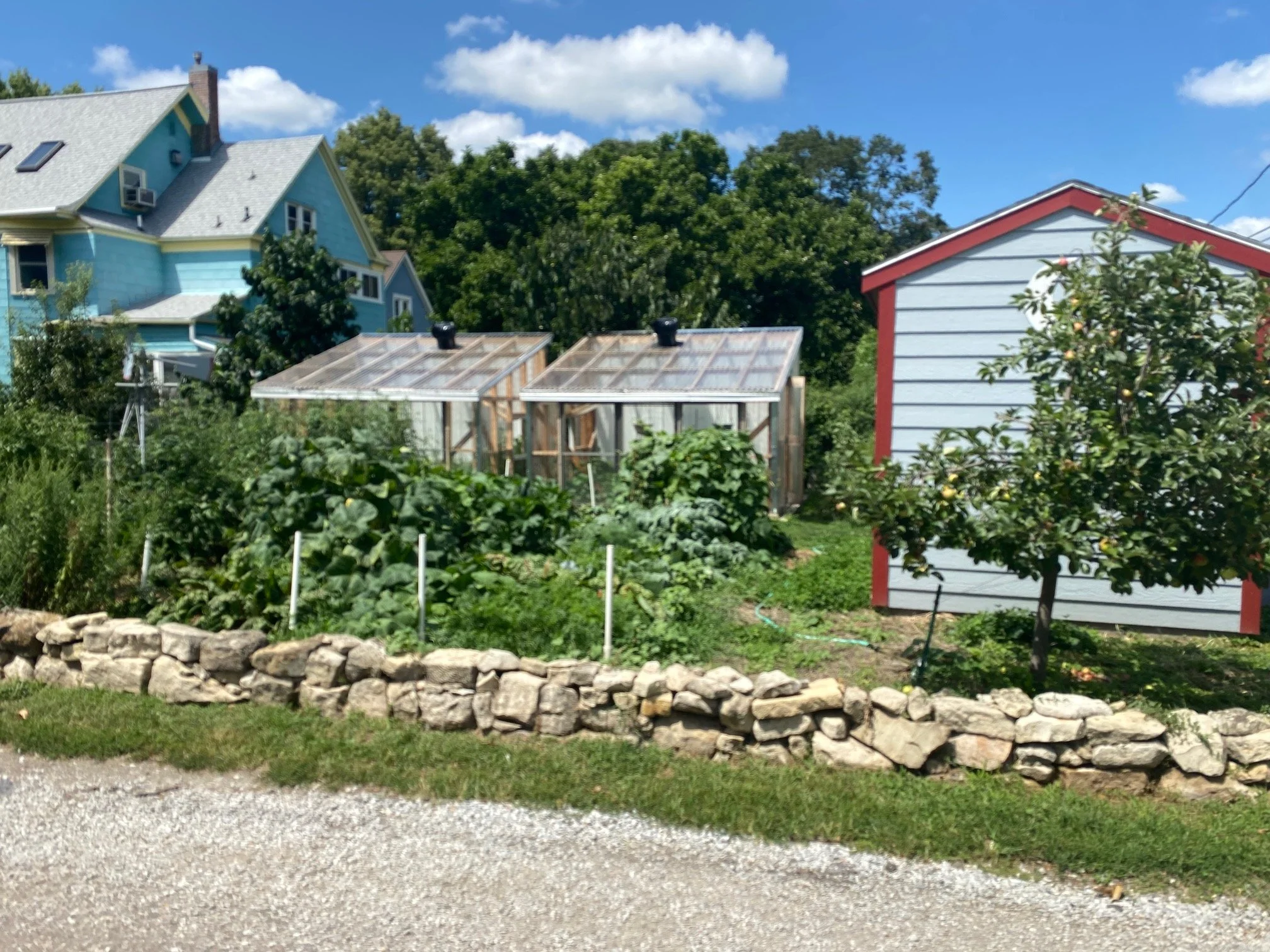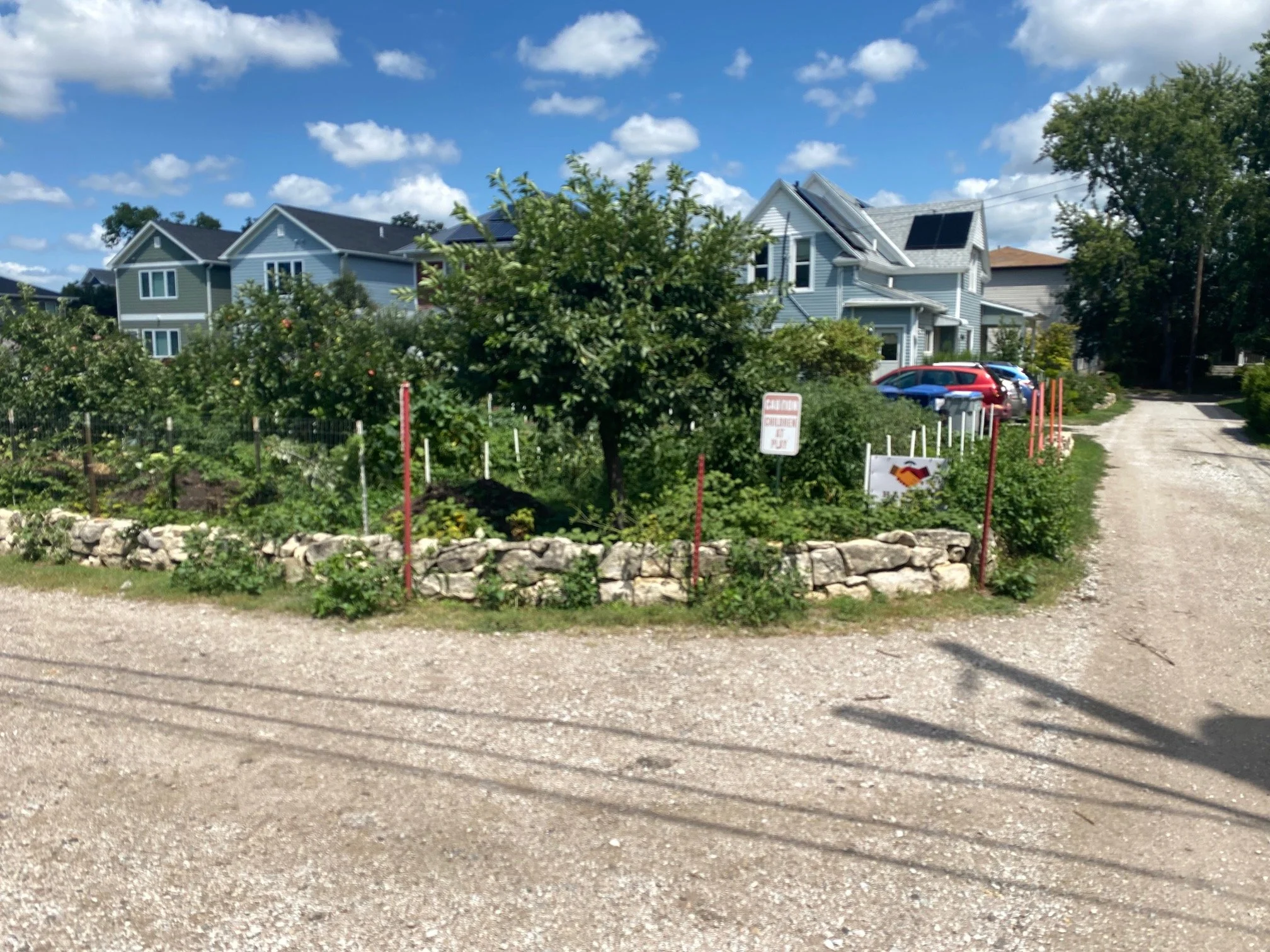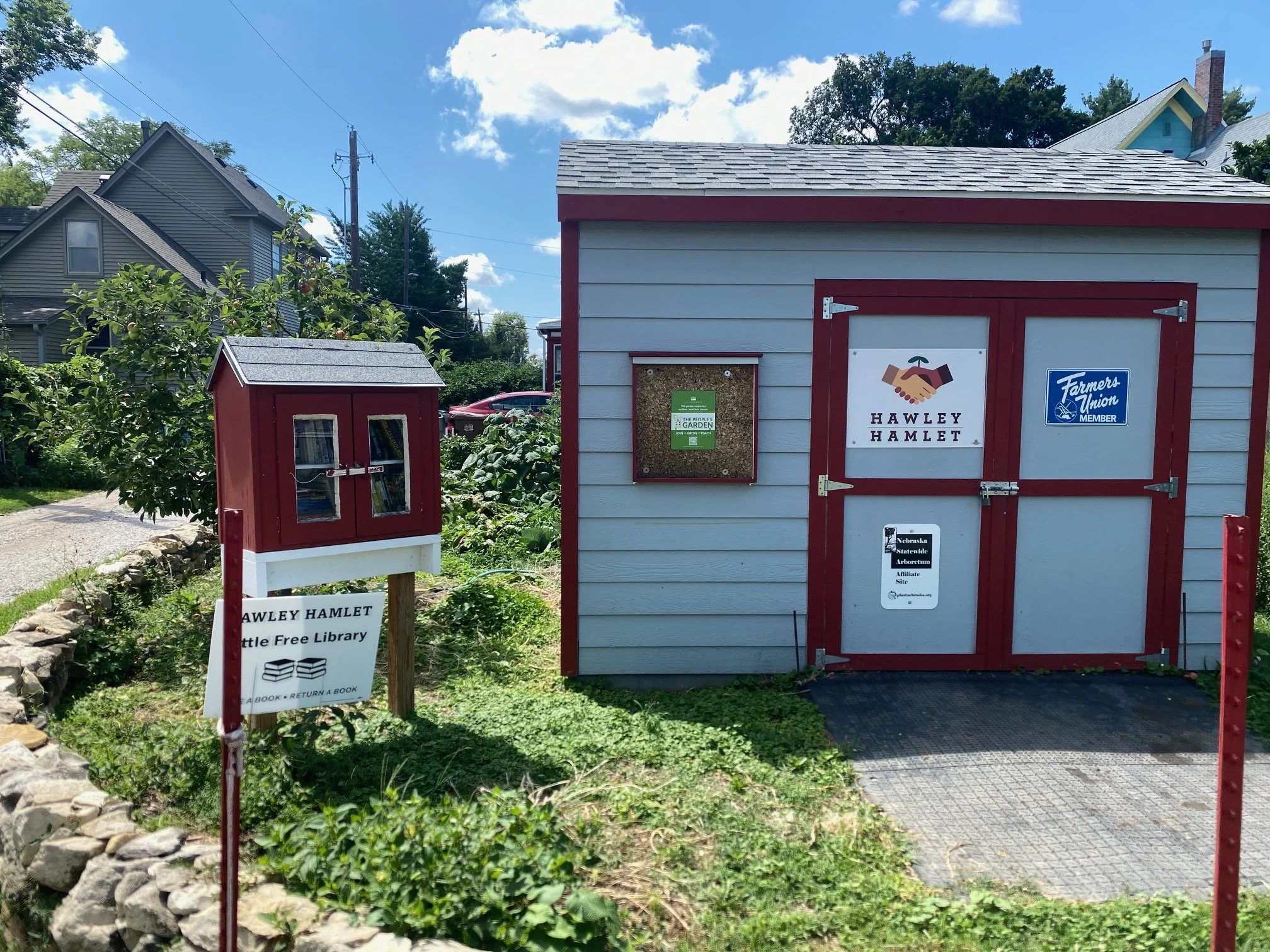Notes From The Field: Visiting Hawley Hamlet
This blog post is a continuation of the Site Visits series where I visit relevant development projects (ecovillages, agrihoods, community gardens, cohousing & conservation communities, etc) to get fresh ideas for the Bennington Agrihood. Site visit #4 of the year was to Hawley Hamlet all the way down in Lincoln, NE.
Hawley Hamlet Neighborhood Garden is a unique site to visit for someone studying master-planned developments because it is not master-planned! No, in fact it’s quite the opposite: a case study in how to incrementally develop in an urban context.
Hawley Hamlet is located on one city block (2 acres) in the heart of Lincoln. It is geographically bounded by North 25th Street to the West, North 26th Street to the East, U Street to the North and T Street to the South.
The Site Tour, Etc.
We met at Hawley Hamlet at 1:30 on the third Sunday of the month - a time designated for monthly hamlet tours. Kay Walter, one of the founders of the hamlet, was nice enough to lead a tour of the site despite the sweltering July heat.
She told us that the idea for Hawley Hamlet can be traced back to reading a book —Edible Landscaping by Rosalind Creasy — which argued for edible landscaping. Ever since 2010, Hawley Hamlet, led by Kay Walter, Tim Rinne, and neighbors, has converted a tremendous amount of landscape from ornamental to edible.
Kay stated that the transformation began with buying homes on the block during the Great Recession. Between 2008 and 2021, some 6 homes on the block were purchased. They would fix up the properties and the yards of these homes were converted to garden beds, sites for fruit trees, berry brambles and pollinator gardens. The homes were then out to tenants who were interested in gardening. These garden beds were made available to residents of the block but also to neighbors in the apartment across the street.
Over time, people began to notice the change and signaled their desire to be a part of it by moving onto the block as homes became available. Those new residents then converted their yards into productive and edible landscapes.
Other orgs took notice such as Neighbor Works got involved with the hamlet by building 3 new homes on the block. Two of these homes are part of a community land trust model in partnership with Prairie Roots Community Land Trust which seeks to keep the homes permanently affordable. Despite these efforts to expand the housing supply at the hamlet, demand continues to outpace supply.
In 2025, Hawley Hamlet is home to some 44 residents who live in 15 houses and a 6 plex. In a follow up email, Kay shared with me that she knows 38 other residents - I have a feeling Kay would be an extreme outlier if this were measured in the General Social Survey!
What I Observed
Well, there was A LOT to take in on just one block! Here’s a rundown of some of the cool things I saw!
The ‘Firsts’ First
I saw for the first time with my own eyes an Espalier tree. An Espalier tree is essentially when you prune a tree to lie flat against a surface. The result can sometimes look like a menorah. The Espalier apple tree at Hawley Hamlet was against Kay and Tim’s home. Espalier trees planted near or against homes can provide fruit and reduce heating/cooling costs - win/win!
My other first was seeing a fruit bearing Paw Paw tree and its fruit. I’ve planted a few of those bad boys on a farm in Central Texas as a WWOOF’er in 2011 but never had the pleasure of seeing it fruit. I still haven’t tasted the fruit which is said to taste tropical like a combination of mango, pineapple and banana. A pretty incredible flavor profile for America’s largest native fruit and a fruit which grows in Nebraska!
Other Things I Saw
Kay told us there were ~60 fruit and nut trees and dozens of garden plots on the block. Everywhere you looked there was a raspberry bush or a grape vine or a pear tree or a pollinator patch - literally everywhere!
There were 4 greenhouses and many solar panels. We saw cofounder, Tim Rinne and neighbor Pat Payne working to prep a site to construct a new community compost facility. We also saw beehives. They got 28 gallons of honey last year from their beehive operation!
Thoughts
I decided to attend their monthly tour last minute as my plans to conduct site visits Ecovillage Ithaca, Prairie Crossing and Chautauqua, NY failed to materialize. I was very pleasantly surprised with the intensity and density of life on the hamlet!
It was a really moving experience to see what you can do by starting out with a couple dedicated people, a very small amount of land, a vision, and time!
As I’ve been working to make Bennington Agrihood a reality, it’s been a blessing to have the opportunity to learn from people and projects who predate my efforts. What’s particularly profound about Hawley Hamlet is that it was developed without the goldilocks conditions of having access to a large plot of unvarnished farmland. Kay and Tim began building their vision where they were, with the resources they had and with the people around them and it’s a beautiful result. As we’ve been working on the Bennington Agrihood, I occasionally am asked something along the lines of “what about the urban communities left behind?” I now think I have a good response to that. Places like Hawley Hamlet and an idea I picked up during my site visit to Dancing Rabbit, the kitchen co-ops concept, would be my top 2 responses for how urban communities can be transformed without master-planning.
Notes on the 3 Environments
Built Environment Notes & Reflections: The built environment feature that stood out to me at Hawley Hamlet was the “T” shaped alley way. I don’t recall ever seeing an alley way like that before but it seems like an incredible design feature to encourage interaction between neighbors. It’s clear that the area near the alley is a major community gathering space. I also really appreciated that the alley was gravel and pervious. There was some interesting stone features that we saw - one as the stone border wall that Tim constructed from buried limestone foundation blocks found in garden beds on the site - the purpose of the wall was both to prevent trash trucks from running over the edges of the garden and to improve the esthetics of the alleyways. Also of note was the urbanite used in patios and entryways. Kay told us that urbanite is the result of breaking old sidewalk or driveway concrete into smaller pieces and flipping it over so the side which was exposed to the soil is now face up - it creates an interesting pattern and way to reuse concrete.
Social Environment Notes & Reflections: The fact that Kay knows 38 of the 44 neighbors is incredible. This speaks volumes to the sense of community that must be felt by residents. There were at least two little free libraries and a tool shed that can be used by gardeners. As mentioned above, a few of the garden beds are cultivated by neighbors who live across the street from the hamlet so I’d imagine this enhances the community feel. There are ways to get outside visitors involved also, Kay mentioned upcoming events and volunteer opportunities. Kay likes to refer to Hawley Hamlet as an “unintentional” community - a nod to their incremental approach to community development. They’ve incorporated community design elements that both build strong internal bonds (bonding capital) and outward connections (bridging capital) alike.
Natural Environment Notes & Reflections: Hawley Hamlet redefined what I think is possible on an acre. The block is actually two acres and .8 acres are under some form of cultivation. I don’t know if there’s anything comparable. It was so intentional. We saw respect for the natural world at every turn from solar arrays to pollinator gardens to pervious surfaces. We passed by a few plantings and were told that birds or squirrels eat all of the fruit/nuts before the residents could enjoy any but that everyone was happy to share with the local wildlife. This is the kind of thing that leads not only to a mindset of abundance but a physical reality of abundance! Crucially, this abundance will remain in perpetuity thanks to the conservation easements that were put on the property.
Final Thought
Hawley Hamlet is an inspiration. It’s given me a whole new perspective for thinking about the design of pocket neighborhoods at the agrihood. I would 10/10 recommend anyone in Nebraska visits this place on the 3rd Sunday of the month.
Want to see it for yourself?
RSVP directly with Kay Walter: kaywalter19@gmail.com or with Tim Rinne: walterinne@gmail.com
Below: Enjoy this slider of pictures taken during my visit to Hawley Hamlet








